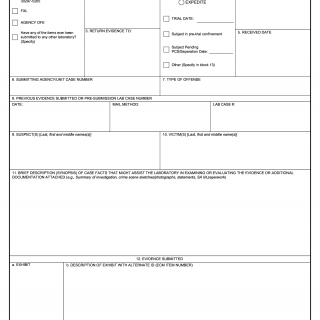DD Form 2922. Forensic Laboratory Examination Request
DD Form 2922 is a Forensic Laboratory Examination Request that is used by law enforcement agencies to request forensic laboratory examination of evidence collected during an investigation.
The main purpose of the form is to provide details about the evidence to be examined and to request specific tests or analyses to be performed by the forensic laboratory. The form includes sections for the submitting agency's information, the nature of the offense, the type of evidence, and the specific tests or analyses requested.
Important fields in the form include the submitting agency's name and contact information, the case number, the type of offense, the type of evidence being submitted, and the specific tests or analyses requested. It is important to provide accurate and detailed information in these fields to ensure that the forensic laboratory can properly process the evidence and perform the requested tests or analyses.
The parties involved in the form are the submitting agency and the forensic laboratory. The submitting agency is responsible for providing accurate information and ensuring that the evidence is properly collected and preserved before submission. The forensic laboratory is responsible for conducting the requested tests or analyses and providing the results to the submitting agency.
When writing the form, it is important to provide as much detail as possible about the evidence and the requested tests or analyses. Additional documents that may need to be attached include the chain of custody documentation and any relevant reports or documents related to the investigation.
Application examples of the form include requests for DNA testing, fingerprint analysis, ballistics testing, and drug analysis. The form is essential for ensuring that evidence is properly analyzed and can be used in court to support a prosecution.
Strengths of the form include its ability to provide detailed information about the evidence and the requested tests or analyses, which helps to ensure that the forensic laboratory can properly process the evidence. Weaknesses of the form include the potential for errors or inaccuracies if the submitting agency does not provide accurate information or if the evidence is not properly collected and preserved.
Opportunities for improvement could include the development of online submission systems that can help to streamline the submission process and reduce errors. Threats to the form include the potential for misuse or abuse by submitting agencies or forensic laboratories.
Related forms include the FBI Laboratory Request Form and the ATF Laboratory Submission Form, which are used for similar purposes but have different requirements and procedures. The main difference between these forms is the agency that is responsible for processing the evidence.
The form affects the future of the participants by providing crucial information that can be used to support a prosecution or exonerate a suspect. Properly analyzing the evidence can help to ensure that justice is served and that the guilty are held accountable for their actions.
The form is typically submitted to the forensic laboratory that will be processing the evidence. Once the examination is complete, the results are provided to the submitting agency and are stored in accordance with applicable laws and regulations.

